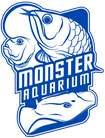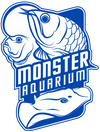FRONTOSA CICHLID
The Frontosa Cichlid, scientifically known as Cyphotilapia frontosa, is a popular fish species among aquarium enthusiasts. It is native to Lake Tanganyika in East Africa, specifically in the rocky coastal areas. Here are some key characteristics and information about the Frontosa Cichlid:
-
Appearance: Frontosa Cichlids are known for their impressive size and striking appearance. They have a large, elongated body with a slightly humped back. Their most notable feature is a prominent forehead or "hump" on the male specimens, which develops as they mature. The coloration of Frontosa Cichlids varies depending on their age and location. Typically, they display a combination of blue and black vertical bars on a silver or white background.
-
Size: These cichlids are one of the larger species available in the aquarium trade. On average, they can grow to about 10-12 inches (25-30 cm) in length. However, some individuals have been known to reach sizes of 14-16 inches (35-40 cm).
-
Behavior: Frontosa Cichlids are generally peaceful and relatively mild-mannered for cichlids. However, they can become territorial and aggressive during breeding or when establishing dominance within a group. It is recommended to keep them in spacious aquariums with plenty of hiding spots and territories to minimize potential conflicts.
-
Tank Requirements: To keep Frontosa Cichlids healthy and happy, it is important to provide them with a suitable environment. A large aquarium with a minimum capacity of 100 gallons is recommended to accommodate their size and to create enough swimming space. The tank should have a sandy substrate, rocks, and caves for them to explore and claim as territories. Water parameters should mimic their natural habitat, with a pH range of 7.8-9.0 and a temperature between 75-80°F (24-27°C).
-
Feeding: In the wild, Frontosa Cichlids are primarily carnivorous, feeding on small fish and invertebrates. In captivity, they can be fed a varied diet consisting of high-quality pellet or flake foods supplemented with occasional feedings of live or frozen foods like brine shrimp, bloodworms, or small fish.
-
Breeding: Frontosa Cichlids are mouthbrooders, meaning the females hold the fertilized eggs in their mouths until they hatch. Breeding can be challenging in captivity due to the complex social dynamics of the species. Adequate space, appropriate water conditions, and the presence of multiple females can increase the likelihood of successful breeding.
Frontosa Cichlids are highly regarded for their unique appearance and behavior, making them a popular choice for experienced aquarium keepers interested in keeping large, peaceful cichlids. It's important to note that they require proper care, adequate space, and suitable tank mates to thrive in a home aquarium.
| Size |
1.5-2”, 6-7”, 8-9” |
|---|



